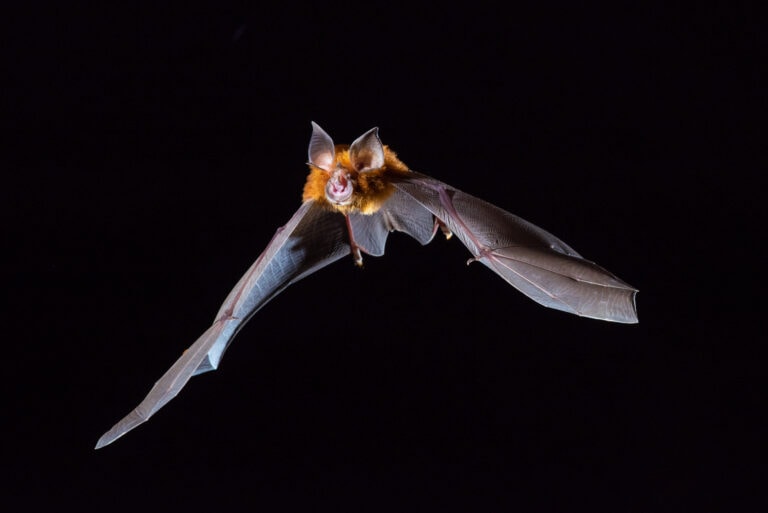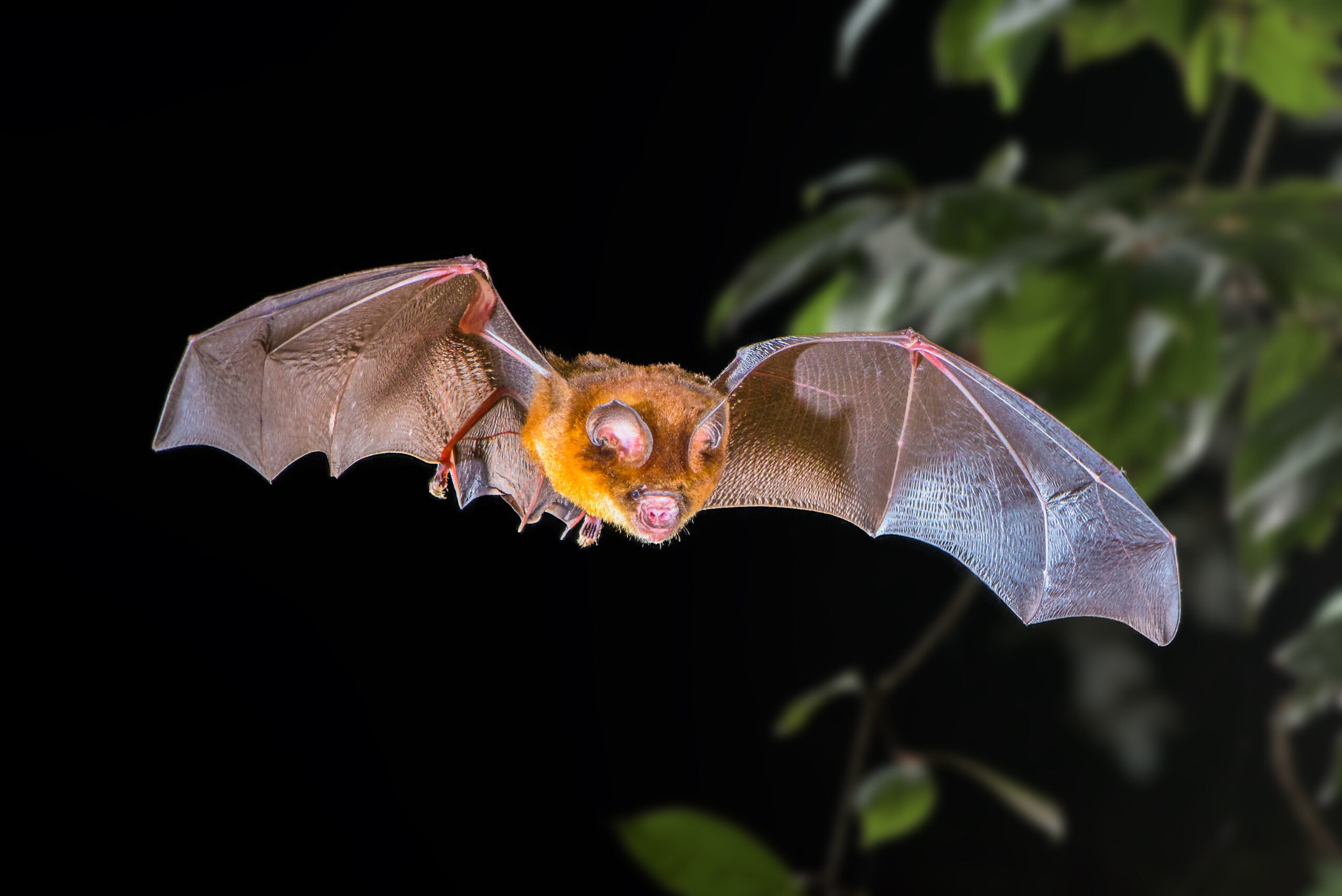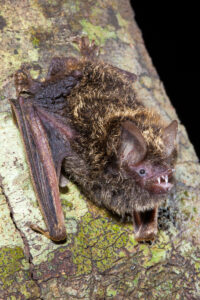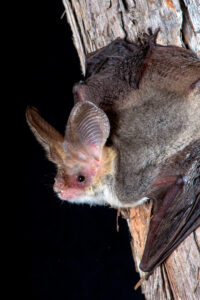TERN is creating the world’s largest online library of bat calls, to be used for identification and biodiversity monitoring in Australia. Unique Australian-made ultrasonic audio equipment makes such recordings possible
Image above: Fawn Leaf-nosed Bat (Hipposideros cervinus) in flight in rainforest Iron Range, Qld Australia (Bruce Thomson)
Bats come in two quite different groups. One type, known as fruit bats or flying foxes (Megachiroptera), is large and conspicuous. Fruit bats find food via site and smell. The other group, the microbats (Microchiroptera), is opposite in many ways.
The microbats’ combination of traits – tiny size, very fast movements, nighttime activity, and being generally dark-coloured – can make them difficult to study. Although microbats are one of the most successful mammal groups, much about them remains unknown. Of Australia’s sixty-odd microbat species, some have already gone extinct, some are under threat, and the status of many others is uncertain.
Identification through sound
Microbats are predators. They catch prey and avoid obstacles using echolocation, a form of sonar. Bats emit a rapid series of clicks and chirps, the echoes of which allow them to detect objects. Bats’ echolocation just overlaps the upper limit of human hearing, yet most of it is far into the ultrasonic, up to ten times higher in pitch than anything human ears can detect.
Yet paradoxically, it is through echolocation that we can study these bats. “Recent advances in ultrasound recording equipment and computer technology mean that we now have the potential to record and identify the high-frequency echolocation calls of bats,” explains Professor Simon Robson of Central Queensland University. “We can use this information to identify them remotely.” This is an improvement on current methods, where bats need to be caught to be identified. That can be time consuming and stressful for the bats.
TERN is supporting an initiative to catalogue Australian microbat calls for identification purposes. “Collectively we have calls for most, if not all, of the echolocating bats in Australia,” continues Professor Robson, “what we don’t have is a central repository for these calls, that provides the opportunity to maximise the information collected by so many excellent bat researchers.” Thus, Professor Robson and his team are working with TERN, over a one-year project, to develop such a repository. This will take the form of a unique Australian bat-call database that TERN will host and use in its biodiversity monitoring program.

Eastern Horseshoe Bat (Rhinolophus megaphyllus) Iron Range, Qld Australia (Image: Bruce Thomson)
TERN’s bat-database
The project accepts recordings from individuals and groups and already contains over 2,000,000 calls from over three-quarters of the Australian microbat species. That many calls may seem excessive, but it is the inclusion of both identified and unidentified calls that Professor Robson sees as one of the strengths of the database. “The calls of individual species can be quite variable both within and across their range and it is only by understanding this variability on a national scale that we can understand our capacity to successfully identify individual species based on their calls alone.”
The collection of identified bat calls is being supplemented by survey efforts targeted at EPBC-listed “Vulnerable” species within Queensland. Bats will be caught in the nets and then carefully removed. While detained, the bats will be identified and their sounds recorded, then they will be released within an hour.
Key to the project are special ultrasonic recorders developed by the Australian company Titley. During the 1980s, this company was first in the world to commercially develop the ultrasound equipment necessary to record bat calls. This equipment is now available as rugged and convenient handheld devices. Solar-powered arrays of these microphones can be set up and left to run automatically for months at a time. The recording system represents a highly significant Australian contribution to the study of bats worldwide.
The database will later be expanded to national coverage. At that stage, researchers will be able to make recordings using the Titley equipment, then compare those recordings against the database for identification. This technique has already led to the identification of one new species. An Australian team unrelated to this study discovered a new species of Horseshoe Bat in early 2022 initially detected by its distinctive call. Further discoveries are likely.
Bat calls are ‘data rich’ and numerous approaches have been employed to identify bat calls to species. Both TERN and Titley are developing online software that facilitates these approaches for individuals while accessing the database.
Left to right. Golden-tipped Bat (Phoniscus papuensis) Bunya Mountains, Qld Australia; Large-eared Horseshoe Bat (Rhinolophus robertsi) Atherton, Qld Australia; Gould’s Long-eared Bat (Nyctophilus gouldii) Cooktown, Qld Australia (Images: Bruce Thomson)
Video abundance monitoring
Sound information can accurately identify species present, but it does not estimate abundance. In collaboration with programs such as the National Southern Bentwing Bat Recovery Plan, TERN will deploy thermal imaging video systems to monitor bat activity at key maternity cave sites. Most bats roost in trees, either individually or in small groups. Yet some species roost communally in maternity caves, where populations can equal medium-sized human cities. “Individuals come from up to one thousand kilometres away to the same site each year to have their young,” explains Professor Robson. “These sites have just the right combination of temperature and humidity to rear offspring and are critical resources for the bats of a large geographic area.” So these sites are invaluable conservation resources. Being able to monitor them, and other roost sites, is vitally important. Such monitoring will indicate any changes in bat numbers over a large area, ultimately helping to protect them.
The combination of sound and video identification, linked to the TERN database, will soon enable real-time monitoring of Australian bats to be added to TERN’s long-term monitoring of changes in ecosystem biodiversity.
More information:
Writing: Wayne Deeker and Simon Robson










